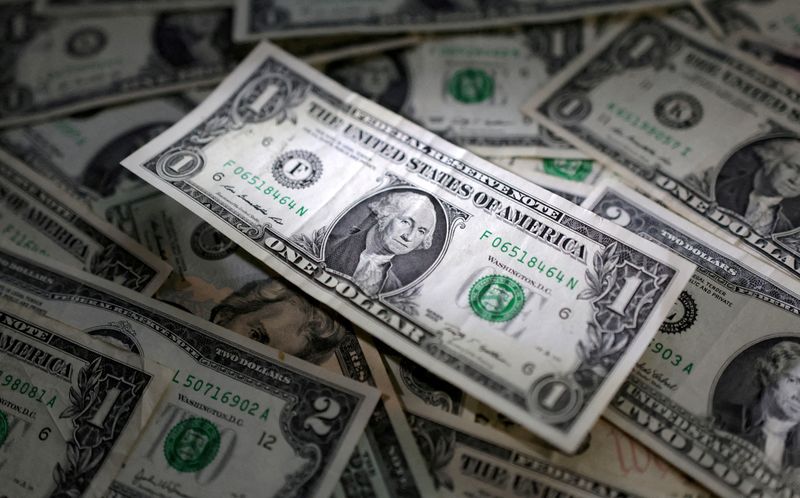Forex
Dollar falls to two-week low as economic data softens


© Reuters. FILE PHOTO: U.S. dollar banknotes are seen in this illustration taken March 10, 2023. REUTERS/Dado Ruvic/Illustration/File Photo
By Karen Brettell
NEW YORK (Reuters) – The dollar dropped to a two-week low against the euro and a basket of currencies on Wednesday after data showed that U.S. private payrolls rose less than expected in August, adding to expectations that the Federal Reserve would stop raising interest rates.
Softening data this week has raised bets that the U.S. central bank has concluded its tightening cycle. It follows a brief increase in expectations for a November rate hike after relatively hawkish comments by Fed Chairman Jerome Powell on Friday.
This Friday’s jobs report for August will be closely watched for further confirmation that the tightness in the labor market is ebbing as interest rates remain relatively high.
“The dollar’s falling on the belief that the Federal Reserve has done enough,” said Adam Button, chief currency analyst at ForexLive in Toronto. “I think nonfarm payrolls will be the final ‘stick the fork in it’ moment if it’s soft.”
Friday’s jobs data is expected to show that employers added 170,000 jobs in August, according to the median estimate of economists polled by Reuters.
Private payrolls rose by 177,000 jobs last month, the ADP National Employment report showed on Wednesday. Economists polled by Reuters had forecast private employment would increase by 195,000.
The greenback also fell on Tuesday after data showed that U.S. job openings dropped to the lowest level in nearly 2-1/2 years in July as the labor market gradually slowed.
Markets now see an 89% chance of the Fed leaving rates unchanged next month, the CME FedWatch Tool showed, and a 46% probability of a hike in November.
Other data on Wednesday showed that the U.S. economy grew at a slightly less brisk pace than initially thought in the second quarter as businesses liquidated inventory.
Personal consumption expenditures due on Thursday will also give new clues on inflation.
The was last down 0.36% at 103.16, after earlier going as low as 102.92. It has fallen from 104.44 last Friday, the highest since June 1.
The greenback gained 0.23% to 146.195 Japanese yen, but remained below a 10-month high of 147.375 reached on Tuesday.
The euro was last up 0.38% at $1.0921. It has bounced from $1.07655 on Friday, the lowest since June 13.
The single currency was boosted by hotter-than-expected inflation in Germany, a day before highly anticipated consumer price data for the euro zone.
German consumer prices increased by an annual 6.4% in August, down from a reading of 6.5% in July but above the 6.3% forecast in a poll of economists surveyed by Reuters.
Spain’s consumer prices also rose to 2.6%, while core inflation fell to 6.1% from 6.2% in July.
The data “add to the uncertainty surrounding the near-term path of ECB policy. On balance, we think that the ECB will raise rates once more in this cycle,” said Hubert de Barochez, markets economist at Capital Economics.
Money markets raised their bets on a September rate hike from the European Central Bank, pricing in a 58% chance of a 25 basis-point move.
Meanwhile, Australian inflation slowed to a 17-month low in July, reinforcing the case for the Reserve Bank of Australia to hold rates steady at its policy meeting next week.
The dollar was last down 0.04% at $0.6478, after earlier dropping to $0.64495.
========================================================
Currency bid prices at 2:50PM (1850 GMT)
Descript RIC Last U.S. Pct YTD High Low
ion Close Change PctCha Bid Bid
Previ nge
ous
Sessi
on
Dollar 103.16 103.5 -0.36% -0.319 +103. +102.
index 00 500 % 7000 9200
Euro/Dol $1.092 $1.08 +0.38% +1.92% +$1.0 +$1.0
lar 1 80 946 856
Dollar/Y 146.19 145.8 +0.23% +11.52 +146. +145.
en 50 700 % 5300 5600
Euro/Yen 159.65 158.7 +0.59% +13.79 +159. +158.
1 % 6900 5600
Dollar/S 0.8785 0.878 +0.03% -4.97% +0.88 +0.87
wiss 4 03 46
Sterling $1.271 $1.26 +0.58% +5.16% +$1.2 +$1.2
/Dollar 7 44 746 620
Dollar/C 1.3537 1.355 -0.08% -0.07% +1.35 +1.35
anadian 1 76 14
Aussie/D $0.647 $0.64 -0.04% -4.98% +$0.6 +$0.6
ollar 8 80 522 450
Euro/Swi 0.9594 0.955 +0.41% -3.04% +0.95 +0.95
ss 5 97 50
Euro/Ste 0.8586 0.860 -0.20% -2.92% +0.86 +0.85
rling 3 10 85
NZ $0.596 $0.59 -0.13% -6.07% +$0.6 +$0.5
Dollar/D 9 72 006 940
ollar
Dollar/N 10.587 10.56 +0.31% +8.02% +10.6 +10.5
orway 0 80 260 330
Euro/Nor 11.566 11.50 +0.52% +10.22 +11.5 +11.5
way 3 70 % 840 000
Dollar/S 10.839 10.86 +0.11% +4.14% +10.9 +10.7
weden 0 72 097 814
Euro/Swe 11.838 11.82 +0.11% +6.17% +11.8 +11.7
den 0 54 665 960

 Forex3 years ago
Forex3 years agoForex Today: the dollar is gaining strength amid gloomy sentiment at the start of the Fed’s week

 Forex3 years ago
Forex3 years agoUnbiased review of Pocket Option broker

 Forex3 years ago
Forex3 years agoDollar to pound sterling exchange rate today: Pound plummeted to its lowest since 1985

 Forex3 years ago
Forex3 years agoHow is the Australian dollar doing today?

 Cryptocurrency3 years ago
Cryptocurrency3 years agoWhat happened in the crypto market – current events today

 World3 years ago
World3 years agoWhy are modern video games an art form?

 Commodities3 years ago
Commodities3 years agoCopper continues to fall in price on expectations of lower demand in China

 Economy3 years ago
Economy3 years agoCrude oil tankers double in price due to EU anti-Russian sanctions


























